Samsung has lauched a lot of new smartphones on the market lately. Many of them are top notch and very popular. So we decided to test one of such cell phones: the Samsung Galaxy Ace. It’s one of the company’s bestsellers due to its high quality and a low price. For a relatively small sum of money you can get an Android-based smartphone which sports an 800 mhz processor, a camera that comes with auto focus and many other useful features that the majority of the newest smartphones can boast of.
The lack of a headset really disappointed us because we had prepared the two interesting tests for it. In the box, besides the data cable and the charger we found a card reader for microSD and another back cover of a white color (Pic. 1, 2).
The phone has a refined design but in appearance it doesn’t differ much from other Android smartphones (Pic. 3, 4). We tested two samples of the Samsung Galaxy Ace.
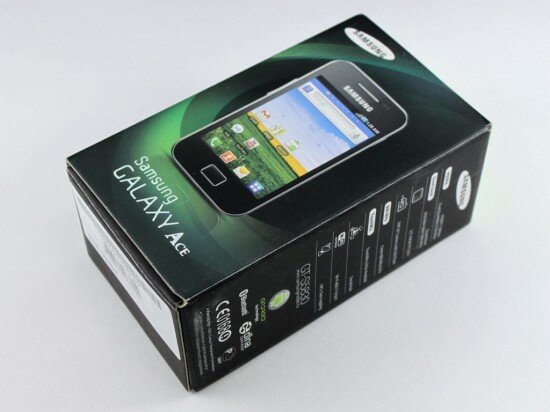
Pic. 1. Package box
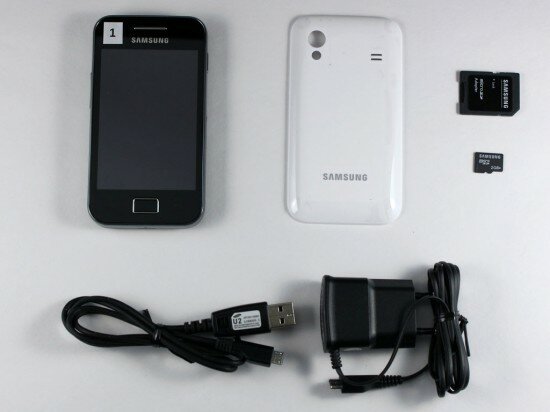
Pic. 2. Accessories
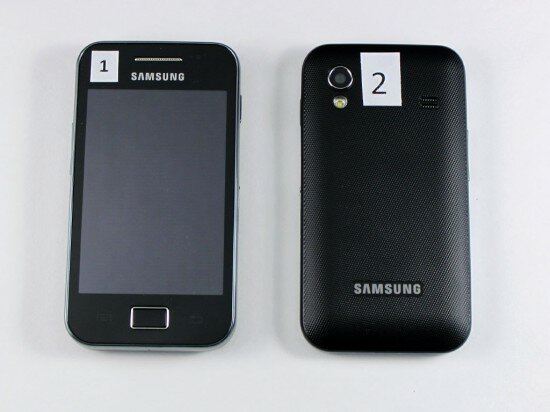
Pic. 3. Front and rear panels of the Samsung Galaxy Ace
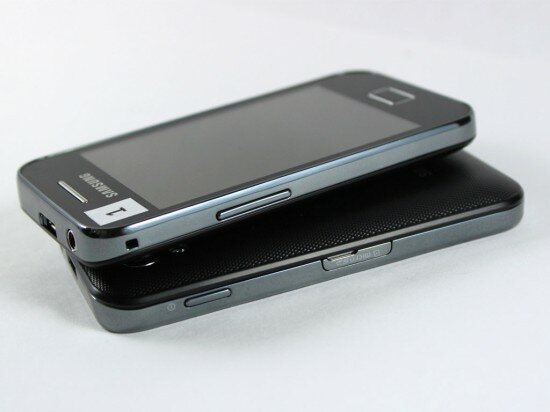
Pic. 4. The edges
The 1st sample of the Samsung Galaxy Ace
1. Reception quality test
We started with checking the phone’s reception ability. In fact, this is not a stress test and it wouldn’t inflict any harm to the phone. We placed the Samsung Galaxy Ace in the box covered in tin foil in order to create poor reception conditions. Actually the signal from towers could be received only through the slots that were cut in the lids. All in all, we had three lids with different slot dimensions: 50 by 50 mm (1.97-inch by 1.97-inch), 20 by 20 mm (0.787-inch by 0.787-inch) and 15 by 15 mm (0.59-inch by 0.59-inch) (video 1 – 3).
The Galaxy Ace received all incoming calls no matter how small the slot was. All the time the screen showed all the bars that indicate signal strength. Sometimes the signal fell by 1 point but it’s a trifle.
Video 1. Reception quality test (part 1)
Video 2. Reception quality test (part 2)
Video 3. Reception quality test (part 3)
Grade (part 1): 3 (with 3 being the highest possible grade)
Grade (part 2): 3 (with 3 being the highest possible grade)
Grade (part 3): 2 (with 3 being the highest possible grade)
2. Freeze test
The latest mobile phones often malfunction in cold weather. Perhaps you noticed that the battery depletes faster if you keep your handset in the external pocket of your jacket while walking on a frosty winter day.
In this experiment we placed the Samsung Galaxy Ace in a freezer. We wanted to keep it there in speaking mode for 2 hours and for 30 minutes more in standby mode.
However our plans were ruined by the phone. It turned off by itself in 15 minutes! Check out video 4 and you’ll see that the battery was absolutely empty. By the way, the phone switched off its backlight trying to increase the battery lifetime. When we plugged the charger into the phone the backlight switched on but it was impossible to charge the battery because it was too cold. The phone warned us about this. The display is not frost resistant at all. In this context the Samsung Galaxy Ace has the worst display that we have ever seen. It malfunctioned even when the phone’s temperature became normal.
But when we warmed the phone up the battery capacity became full. We didn’t even need to charge it.
Video 4. The phone after the freeze test
Grade: 1 (with 3 being the highest possible grade)
3. Short circuit of the battery charger
In the following three chapters we are going to tell you about the tests that help to check the phone’s electric circuits. And at first we made a short circuit of the battery charger. We closed the terminals (+ and -) of the charger with the help of the forceps (video 5).
The battery charger sustained no damage and stayed functional.
Video 5. Short circuit of the battery charger
Grade: 3 (with 3 being the highest possible grade)
4. Short circuit of the battery
We also closed the terminals of the battery (+ and -) for 1 second (video 6). The battery contains a microchip that protects it from short circuits and overcharging. It did its job fine and the battery didn’t even deplete.
Video 6. Short circuit of the battery
Grade: 3 (with 3 being the highest possible grade)
5. The raise in charging voltage
In this test we found out how the Samsung Galaxy Ace can deal with a non-original charger. We tried to simulate such situation by plugging a power supply unit into the phone instead of the original charger. Then we simply raised charging voltage from 5 to 8 volts (video 7).
The phone successfully passed this test. The current consumption rose up only to 530 mА. It means that the Galaxy Ace has a stabilization system which protects it from such mishaps.
Video 7. The raise in charging voltage
Grade: 3 (with 3 being the highest possible grade)
6. Overvoltage
This time we tested the phone’s circuit board and particularly its ability to withstand overvoltage. We took out the battery and plugged the power supply unit into the phone again and raised the rate of energy from 4.2 to 7 volts (video 8).
The current consumption continued to rise till we stopped to raise the rate of energy. This is not a very good result. The phone is not ready to cope with overvoltage. But it sustained no damage and passed this test.
Video 8. Overvoltage
Grade: 2 (with 3 being the highest possible grade)
7. Leaving the phone out in the rain
Have you ever left your mobile phone out in the rain? In this test we simulated such situation at our lab. The Samsung Galaxy Ace was getting wet in the “rain” for 1 minute (video 9).
The microSD cap is very useful because there was absolutely no water inside the slot (Pic. 5). However, the circuit board got wet by water that penetrated through the back cover (Pic. 6). Fortunately the circuit board stayed functional and the phone worked fine. The display responded with no problem. But the stereo speaker started to produce a very quiet sound. After drying it became loud again. In general, the handset sustained no serious damage.
Video 9. Leaving the phone out in the rain

Pic. 5. The microSD slot

Pic. 6. Water in the battery compartment
Grade: 3 (with 3 being the highest possible grade)
8. Immersion in water at a shallow depth
This time we immersed the phone in water for 20 seconds (video 10). The device passed this test even better than the previous one because there was less water inside. But the stereo speaker malfunctioned again. We solved this problem very soon by drying it out.
Video 10. Immersion in water at a shallow depth
Grade: 3 (with 3 being the highest possible grade)
9. Immersion in water at one meter (3.28 feet) for 20 seconds
This is the Samsung Galaxy Ace’s second immersion in water. We submerged it to 1m (3.28 feet) for 20 seconds (video 11). The phone was in speaking mode during that time.
During the test our call was dropped and the picture on the screen disappeared. But the phone didn’t turn off by itself and we even felt a slight vibration when we pressed the touchscreen. The picture on the screen appeared for sometimes but in a moment the screen became blank again. Water penetrated in all parts of the phone due to a high pressure on the bottom of the pipe. We found some drops even between the screen and the display. The microSD cap didn’t save the slot from water this time (Pic. 7).
We could switch on the phone only after a six hour drying. It worked with no problem. But some spots remained on the screen glass (Pic. 8). They were visible only at an angle. In some days they disappeared at all.
Video 11. Check out how we dunked the phone under water at a 100 cm depth
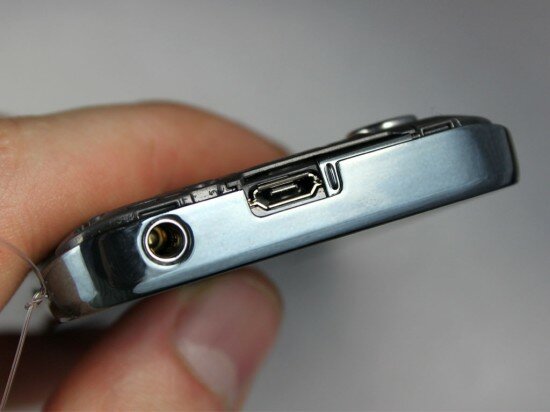
Pic. 7. Water in the microSD slot
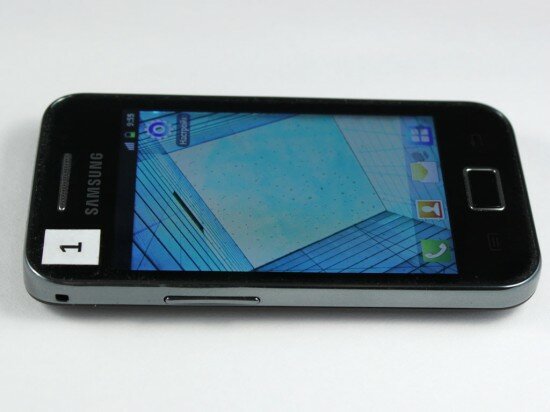
Pic. 8. Spots on the screen
Grade: 2 (with 3 being the highest possible grade)
Grade: 2 (with 3 being the highest possible grade)
10. Immersion in water at a one meter depth for 30 minutes
Only IPx1-IPx6 waterproof cell phones are eligible for this test.
Grade: –
11. Immersion in water at a two meter depth
Only IPx7 waterproof cell phones are eligible for this test.
Grade: –
12. Immersion in beer
Beer is the most popular alcoholic drink in the world. Sometimes careless or merry people spilt it on their mobile phones.
But we dunked the Samsung Galaxy Ace under beer on purpose for 10 seconds (Video 12).
As it often happens to smartphones, the capacitive touchscreen of the Galaxy Ace didn’t respond when we pressed it after the test. Such reaction can be explained the following way: beer is a great conductor of current and sensor can’t understand where exactly you touch the screen. The phone’s innards and the circuit board stayed dry. We found no water in the battery compartment.
We washed the phone and dried it out. After that it performed with no problem as if it hadn’t even been dunked under beer.
Video 12. Immersion in beer
Grade: 3 (with 3 being the highest possible grade)
13. Disassembling. Build quality
The first sample of the Samsung Galaxy Ace passed all the stress tests that had been prepared for it. We disassembled this smartphone (Pic. 9). It was quite easy. We had to drive out only 6 screws.
We were glad to see some interesting features in the design of the phone. For example, the screen and the sensor are attached to a steel frame which makes them rigid. By the way, such frame allows to produce ultra-thin mobile phones like the Galaxy Ace. Moreover, the frame contains the shields that divide different areas of the circuit board and protect the board if you drop the phone, for example. As you see, this design technique can solve three very important problems that may occur to the handset.
The circuit board is nothing to boast of (Pic. 10). It is large but there is a lot of empty space on it. The stereo speakers, the camera, the light sensor and the display are attached to the board by removable elements. The buttons and the microphone are soldered to the board.
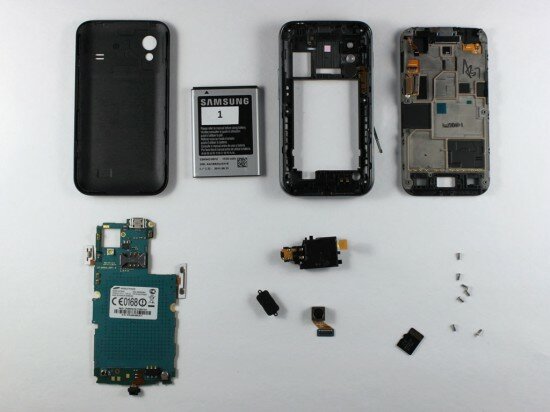
Pic. 9. The phone disassembled
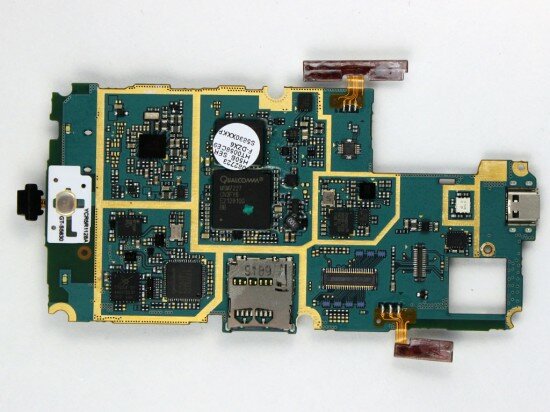
Pic. 10. The circuit board
Grade: 3 (with 3 being the highest possible grade)
14. Test of the charger cable (bend test)
The Samsung Galaxy Ace came to our hands without a headset. So we decided to test the cable of the battery charger instead of the headset cable. We locked the cable in a special device which bended different areas of the wire many times (video 13). The whole experiment was divided into three parts according to the amount of bends that we made (1000, 1500 and 2000 bends).
We checked the work of the headset after each part of the test. It sustained no damage and stayed functional.
Video 13. Test of the headset cable (bend test)
Grade (after 1000 bends): 3 (with 3 being the highest possible grade)
Grade (after 1500 bends): 3 (with 3 being the highest possible grade)
Grade (after 2000 bends): 3 (with 3 being the highest possible grade)
15. Test of the charger cable (tear the wire)
In this test we tried to tear the charger cable by hanging loads on it (video 15). We used three different loads. Each of them weighed 1 kg (2.2 lbs). We hanged them all on the charger and fortunately it survived.
Video 14. Test of the charger cable (tear the wire)
Grade (part 1): 3 (with 3 being the highest possible grade)
Grade (part 2): 3 (with 3 being the highest possible grade)
Grade (part 3): 3 (with 3 being the highest possible grade)
The second sample of the Samsung Galaxy Ace
1. Reception quality test
We tested the reception of the second sample of the Samsung Galaxy Ace and got the same results. The phone received all incoming calls.
Grade (part 1): 3 (with 3 being the highest possible grade)
Grade (part 2): 3 (with 3 being the highest possible grade)
Grade (part 3): 3 (with 3 being the highest possible grade)
2. Talk time
The latest smartphones are equipped with powerful processors while their batteries are not improved. It has a negative impact on the phone’s talk and stand by time.
In this test we estimated the Samsung Galaxy Ace’s talk time. At first we charged the battery and made a call which was received by the phone. Then we only had to repeat our calls because we were disconnected every hour. We did it until the battery became empty. We didn’t switch off 3G and let the Galaxy Ace choose a network by itself. All in all the handset worked for 9 hours being powered by the 1350 mAh battery. By the way, if you read the official phone’s specification you’ll see that the talk time is only 6 hours and 10 minutes.
Grade: 3 (with 3 being the highest possible grade)
3. Drops on the carpet
Everybody dropped his or her handset. And every handset should be ready to stand up to knocks and bumps. In this test we dropped the Samsung Galaxy Ace on the carpet with each face, edge and corner from 100 cm (3.28 ft), 150 cm (4.9 ft) and 200 cm (6.56 ft) (video 15 – 17).
As a result of the 100 cm and 150 cm drops the back cover opened several times but it fell off only when we dropped the phone from 200 cm.
The phone showed no visible damage and continued to work pretty fine.
Video 15. Drops on the carpet from 100 cm (3.28 ft)
Video 16. Drops on the carpet from 150 cm (4.9 ft)
Video 17. Drops on the carpet from 200 cm (6.56 ft)
Grade (100 cm): 3 (with 3 being the highest possible grade)
Grade (150 cm): 3 (with 3 being the highest possible grade)
Grade (200 cm): 3 (with 3 being the highest possible grade)
4. Drops on a tile
This time we dropped the Samsung Galaxy Ace on a tile from 30 cm (11.8 inches), 50 cm (1.64 ft) and 100 cm (3.28 ft) (video 18 – 20). All in all, the phone fell for 6 times from each height.
The phone easily survived the drops from 30 cm. But when we dropped it from 50 cm the cap of the microSD slot opened and we had to put it back. In the final part of this experiment the battery fell out of its compartment for several times. But the handset showed no visible damage.
Video 18. Drops on the tile from 30 cm (11.8 inches)
Video 19. Drops on the tile from 50 cm (1.64 ft)
Video 20. Drops on the tile from 100 cm (3.28 ft)
Grade (stage 1): 3 (with 3 being the highest possible grade)
Grade (stage 2): 3 (with 3 being the highest possible grade)
Grade (stage 3): 3 (with 3 being the highest possible grade)
5. Squeeze test
We placed a wooden bar on the phone and applied pressure from this bar above the casing. At first we applied 5 kg (11 lbs) and then 20 kg (44 lbs). The device showed no damage. Finally we applied 50 kg (110 lbs) and the phone also sustained no harm (Pic. 11).
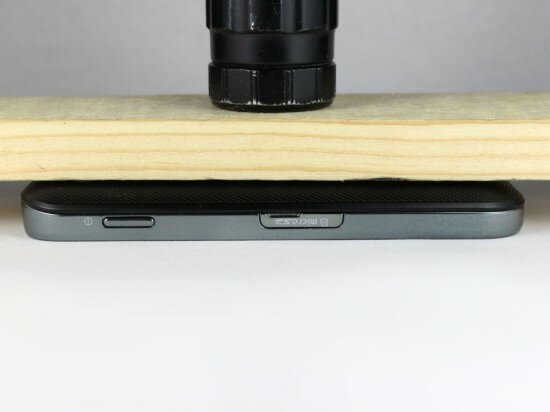
Pic. 11. Squeeze test
Grade (5 kg): 3 (with 3 being the highest possible grade)
Grade (20 kg): 3 (with 3 being the highest possible grade)
Grade (50 kg): 3 (with 3 being the highest possible grade)
6. Bend test
Your mobile phone can be bended even when you keep it in your back pants pocket. It’s clear that you won’t crash the screen or sensor but in some time the parts of your handset may become loose and produce unpleasant noise.
In this test we put the Samsung Galaxy Ace onto the two planks so that each edge of the phone lay on a single plank. Then we hitched a string with a load on top of the device. At first we used the load that weighed 3 kg (6.6 lbs), then we changed it for a 7 kg load (15.4 lbs) and at last we used a 15 kg load (33 lbs).
This phone is really rigid. Even under the 15 kg load the bend was almost invisible (Pic. 12).
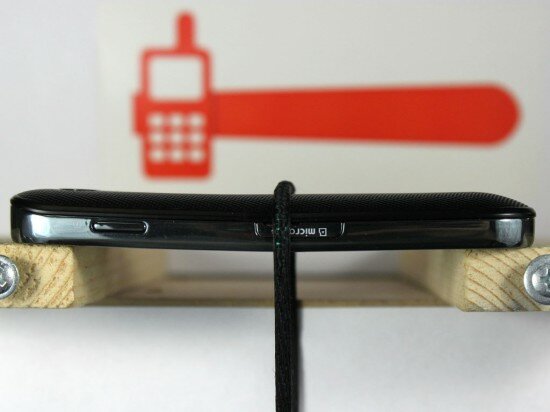
Pic. 12. The influence of the 15 kg load on the phone
Grade (3 kg): 3 (with 3 being the highest possible grade)
Grade (7 kg): 3 (with 3 being the highest possible grade)
Grade (15 kg): 3 (with 3 being the highest possible grade)
7. Keyboard
Today we can rarely see a smartphone with physical buttons. In a few years they may disappear at all. And from one side this is a positive tendency because buttons are prone to different damages. We consider them (and slots too) the weakest elements of a cell phone.
The Samsung Galaxy Ace has three physical buttons. The volume rocker and power button provide you with a comfortable tactile feeling. However, the seams around the button on the front panel let dust inside the phone. Nevertheless, this button is really useful and we have no claims for its performance.
Grade: 3 (with 3 being the highest possible grade)
8. Dust and sand
We already checked water resistance of the first sample of the Samsung Galaxy Ace. And now we are going to tell you about dust resistance of this smartphone. Moreover, we found out how the body of the phone would look like after the contact with sand.
We placed the handset in the drum filled with dust and sand and rotated this drum viciously for three periods of time: 1, 3 and 6 minutes (video 21). We examined the state of the phone after each part of the test.
Check out picture 13 and you’ll see how the phone looked like after the 1 minute rotation. The polyphonic speaker got dirty (Pic. 14). But we didn’t find much dust in the jack and in the microUSB slot (PiIc. 15). When we wiped the dust off the phone we saw several scratches on the steel band that runs around the screen (Pic. 16). This is a serious damage if you take into consideration that the handset spent only 1 minute in the drum.
After the next 3 minutes of rotation the phone sustained more damage than the previous time. The microSD slot got dirty (Pic. 17). The stereo speaker became quieter though we heard no noise while speaking on the phone.
After the final part of the test there was a lot of dust in the battery compartment (Pic. 18). We found many grains of dust under the speaker grill too (Pic. 19). As a result, the stereo speaker became much quieter than the previous time. The phone showed several deep scratches (Pic. 20).
We’ll tell you what happened with the speaker in the chapter “Disassembling. Build quality”.
Video 21. Dust test
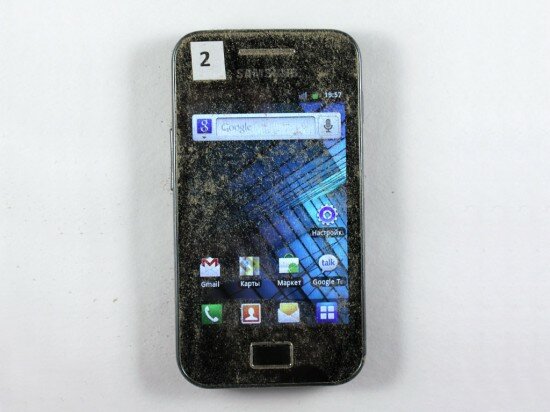
Pic. 13. Here
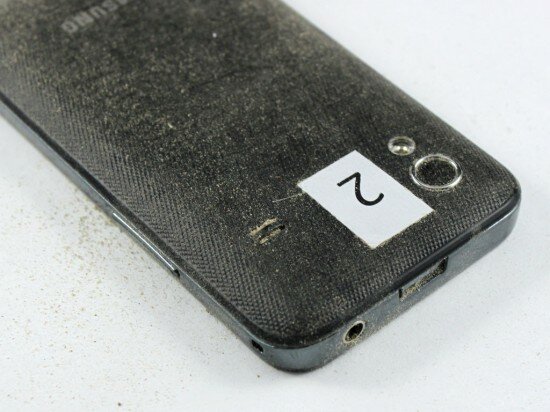
Pic. 14. Dust in the polyphonic speaker
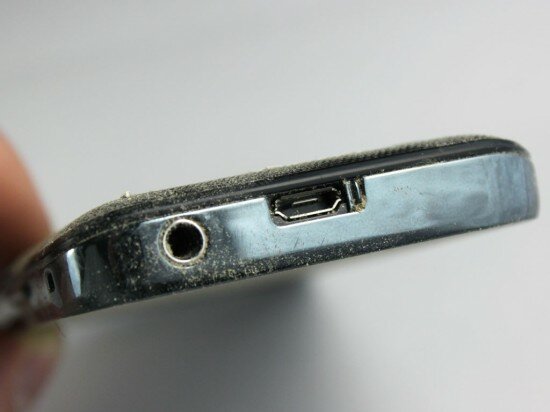
Pic. 15. Dust in the jacks
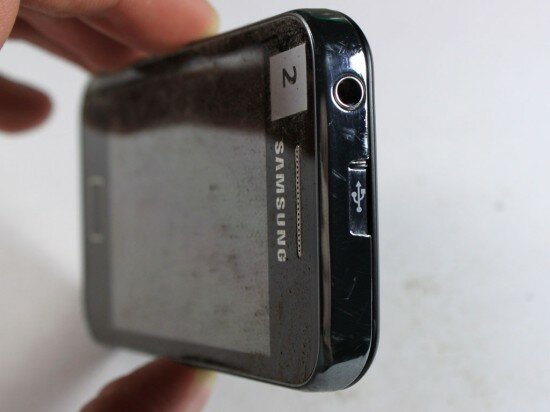
Pic. 16. Here
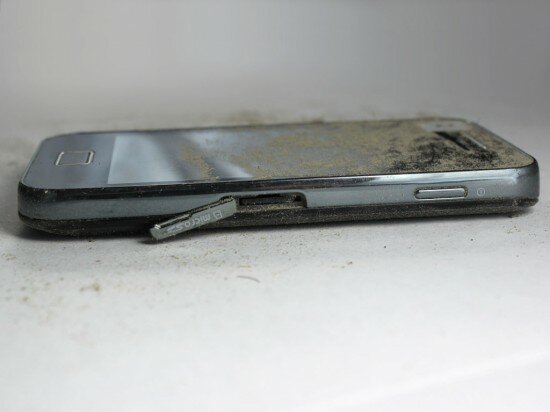
Pic. 17. Dust in the microSD slot
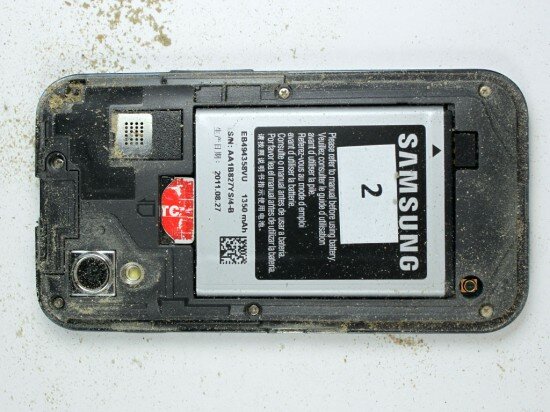
Pic. 18. Dust and sand in the battery compartment
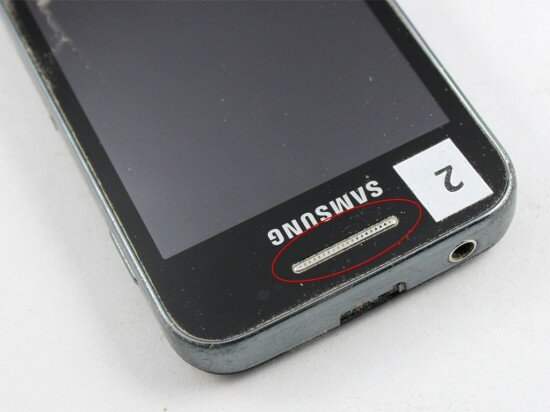
Pic. 19. Dust in the speaker grill
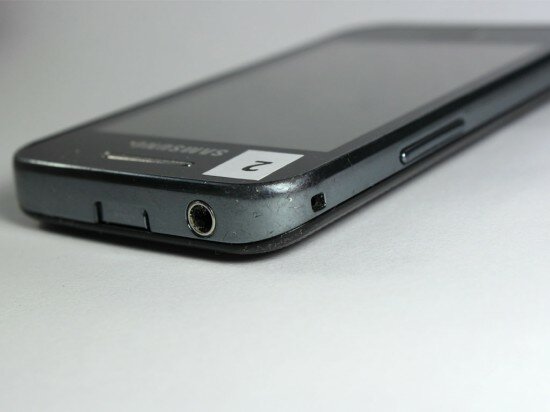
Pic. 20. Here
Grade (1 minute): 2 (with 3 being the highest possible grade)
Grade (3 minutes): 2 (with 3 being the highest possible grade)
Grade (6 minutes): 2 (with 3 being the highest possible grade)
9. Durability test
If you don’t use a case and carry your mobile phone simply in your bag or pocket you risk to have a scuffed screen sooner or later. In this test we checked the Samsung Galaxy Ace’s screen durability. We placed the phone with its face down in a pallet filled with small plastic balls and vibrated the pallet slightly in order to scuff the screen (video 22). We also spilt a little dust and sand in the pallet to cause more harm to the handset. This experiment was divided into three parts according to the periods of time (1, 2 and 5 hours).
After a 1 hour test there was no visible damage on the screen. After the next 2 hours we saw some tiny scuffs. When the whole test was finished the scuffs became more noticeable but they didn’t ruin the picture on the screen and were almost invisible in the bright lights (Pic. 21).
Video 22. Durability test
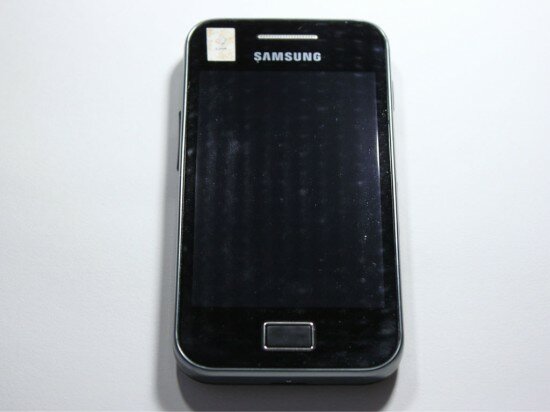
Pic. 21. Scuffs on the screen
Grade (1 hours): 3 (with 3 being the highest possible grade)
Grade (2 hours): 3 (with 3 being the highest possible grade)
Grade (5 hours): 3 (with 3 being the highest possible grade)
10. Scratch test (the screen)
In order to check the screen’s scratch resistance we scratched it for three times with different force. We put the handset on a table and placed a plank with a nail above it so that the tip of the nail touched the screen. Then we took the phone from under the nail thus making the nail run along the screen. Each time we applied different weight above the plank: 100 g (0.22 lbs), 300 g (0.66 lbs) and finally 600 g (1.3 lbs) (video 23).
We know that capacitive touchscreens are scratch proof and the Samsung Galaxy Ace’s screen is not an exception. It showed no scratches at all.
Video 23. Scratch test
Grade (the 1st attempt): 3 (with 3 being the highest possible grade)
Grade (the 2nd attempt): 3 (with 3 being the highest possible grade)
Grade (the 3rd attempt): 3 (with 3 being the highest possible grade)
11. Scratch test (back panel)
We scratched the back panel the same way (video 28). The force of scratching was the same: 100 g (0.22 lbs), 300 g (0.66 lbs) and 600 g (1.3 lbs).
The ribbed back panel of the Galaxy Ace provides you with a comfortable tactile feeling and we thought that it is also scratch resistant due to such structure. However, it sustained one visible scratch after the test (Pic. 22).
Video 24. Scratch test (back panel)
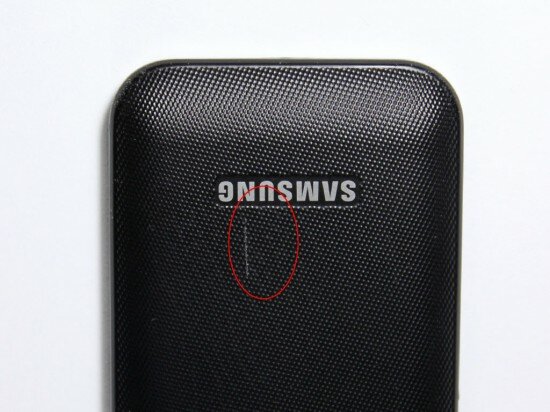
Pic. 22. Scratch on the back panel
Grade (the 1st attempt): 3 (with 3 being the highest possible grade)
Grade (the 2nd attempt): 3 (with 3 being the highest possible grade)
Grade (the 3rd attempt): 2 (with 3 being the highest possible grade)
12. Screen cracking
We checked the rigidity of the phone’s screen by dropping a small steel ball on it. The diameter of the ball is 15 mm (0.59 inches). We dropped it for three times from 10, 20 and 30 cm (3.9, 5.9 and 9.8 inches) (video 25).
The screen sustained no visible damage.
Video 25. Dropping the steel ball on the phone’s screen
Grade (the 1st attempt): 3 (with 3 being the highest possible grade)
Grade (the 2nd attempt): 3 (with 3 being the highest possible grade)
Grade (the 3rd attempt): 3 (with 3 being the highest possible grade)
13. Heat test
In this test we simulated influence of direct sun rays or a flame on the Samsung Galaxy Ace. We placed the handset under the two strong lamps. Each of them heated the phone for 3, 5 and 10 minutes (video 26 – 28). We checked the state of the gadget after these periods of time.
After the 3 minute and 5 minute tests the temperature of the phone was no more than 66 °С (32 °F). But the Galaxy Ace was pretty hot at the end of the experiment (90 °С or 194 °F). The display became dim. But soon the picture on the screen restored. There were no melted areas on the phone’s body.
Video 26. 3 minute heating
Video 27. 5 minute heating
Video 28. 10 minute heating
Grade (3 minute heating): 3 (with 3 being the highest possible grade)
Grade (5 minute heating): 3 (with 3 being the highest possible grade)
Grade (10 minute heating): 3 (with 3 being the highest possible grade)
14. The Samsung Galaxy Ace smash
This is the last stress test for the second sample of the Samsung Galaxy Ace. The phone looked attractive and we felt pity for it because we had to smash it – this is our job. By the way, the phone had all the chances to stay functional and sustain minimum damage due to the steel frame inside it.
We dropped the handset on the tile. Actually we repeated the drop test. But this time the phone fell from 150, 200 and 240 cm (4.9, 6.56 and 7.87 ft).
The experiment didn’t last long (video 29). The screen glass was cracked after the second drop on the tile (Pic. 23). We have never seen a smartphone with a capacitive touchscreen that could pass this test.
We examined the cracks on the screen and came to the conclusion that the glass was broken because of a bump against the tile and not because of the phone’s deformation as it had happened to the HTC Desire. If the screen had been set a little bit deeper it could have survived. But anyway, it wouldn’t save it from falls on the pavement.
Video 29. Drops on the tile from 150 cm (4.9 ft)
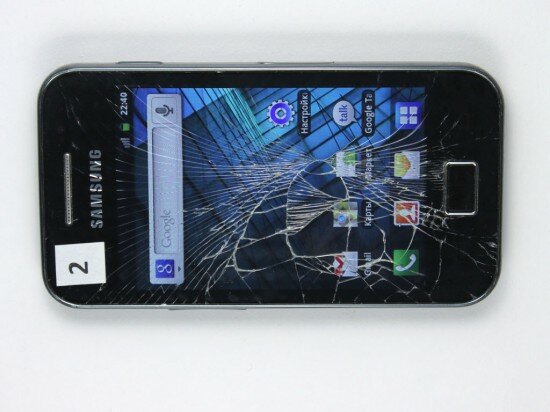
Pic. 23. The broken screen glass
Grade (150 cm): 2 (with 3 being the highest possible grade)
Grade (200 cm): 0 (with 3 being the highest possible grade)
Grade (240 cm): 0 (with 3 being the highest possible grade)
15. Disassembling. Build quality
We disassembled the second sample of the Samsung Galaxy Ace after all the stress tests. Our aim was to find out why the stereo speaker stopped working after the dust test. As you can see from picture 24, it was very dirty. The area between the speaker and the grill was filled with dust. Disassembling helped to find a weak point in the phone’s construction. So we’d like to put a good grade for the Galaxy Ace’s build quality (but not the highest, of course).
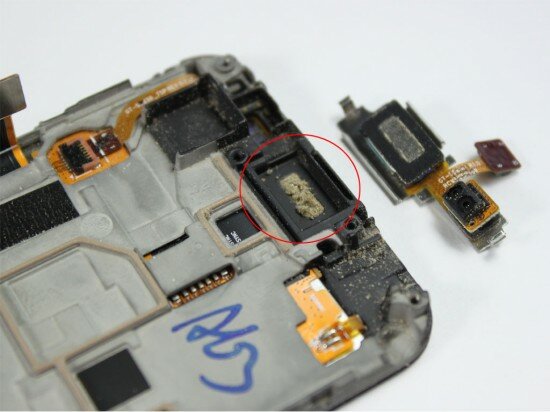
Pic. 24. Dirt in the speaker
Grade: 2 (with 3 being the highest possible grade)
All in all, the Samsung Galaxy Ace gains 602 points (from 686 possible)
Final words
The Samsung Galaxy Ace showed approximately the same results as the other smartphones. But the general mark for this gadget should be a little bit lower than average because of the broken screen. This is Achilles’ heel of all the handsets that have ever been dropped on a tile from big heights.
Among the other disadvantages of the Samsung Galaxy Ace we should mention the lack of dust resistance. Grains of dust and sand penetrated in the speaker grill through the gaps in it. As a result, the sound quality was ruined. The phone is glossy and easily gets scratches and scuffs. By the way, it’s very difficult to use it on a cold winter day because the battery depletes in 15 minutes.
Among the advantages we should mention the phone’s water resistance. It stayed functional despite the wet innards and circuit board. The heat test was also passed successfully. After the freeze test the phone didn’t let us to charge the battery because it was too cold (it wouldn’t be charged properly anyway). We also couldn’t charge the battery after the heat test because it is dangerous and the Samsung Galaxy Ace understands this. The handset is made of a fine quality material despite the steel band around the screen which sustained several scratches. The back cover and the screen are scratch proof.
You may check out how both samples of the Samsung Galaxy Ace look like after all the stress tests (Pic. 25 – 27, video 30).
Video 30. Here’s how both samples of the Samsung Galaxy Ace look like after all the stress tests
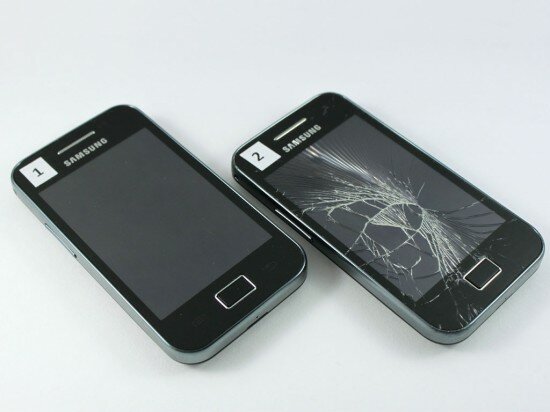
Pic. 25. Front panel
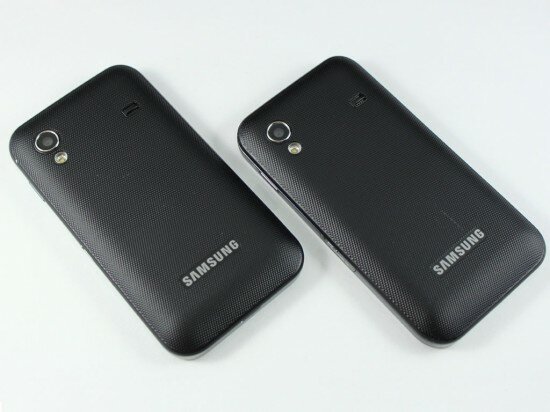
Pic. 26. Back panel

Pic. 27. The edges

 Russian version
Russian version